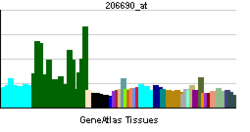ASIC2
| View/Edit Human | View/Edit Mouse |
Acid-sensing ion channel 2 (ASIC2) also known as amiloride-sensitive cation channel 1, neuronal (ACCN1) or brain sodium channel 1 (BNaC1) is a protein that in humans is encoded by the ASIC2 gene. The ASIC2 gene is one of the five paralogous genes that encode proteins that form trimeric acid-sensing ion channels (ASICs) in mammals. The cDNA of this gene was first cloned in 1996.[4][5][6][7] The ASIC genes have splicing variants that encode different proteins that are called isoforms.
These genes are mainly expressed in the central and peripheral nervous system.
ASICs can form both homotrimeric (meaning composed of three identical subunits) and heterotrimeric channels.[8][9]
Structure and function
This gene encodes a member of the ASIC/ENaC superfamily of proteins.[10] The members of this family are amiloride-sensitive sodium channels that contain intracellular N and C termini, 2 hydrophobic transmembrane (TM) regions, and a large extracellular loop, which has many cysteine residues with conserved spacing. The TM regions are generally symbolized as TM1 (clone to N-terminus) and TM2 (close to C-terminus).
The pore of the channel through which ions selectively flow from the extracellular side into the cytoplasm is formed by the three TM2 regions of the trimer. [11]
References
- ↑ "Drugs that physically interact with Acid-sensing ion channel 2 view/edit references on wikidata".
- ↑ "Human PubMed Reference:".
- ↑ "Mouse PubMed Reference:".
- ↑ Waldmann R, Voilley N, Mattéï MG, Lazdunski M (Oct 1996). "The human degenerin MDEG, an amiloride-sensitive neuronal cation channel, is localized on chromosome 17q11.2-17q12 close to the microsatellite D17S798". Genomics. 37 (2): 269–70. doi:10.1006/geno.1996.0558. PMID 8921408.
- ↑ Price MP, Snyder PM, Welsh MJ (Apr 1996). "Cloning and expression of a novel human brain Na+ channel". The Journal of Biological Chemistry. 271 (14): 7879–82. doi:10.1074/jbc.271.14.7879. PMID 8626462.
- ↑ Waldmann R, Champigny G, Voilley N, Lauritzen I, Lazdunski M (May 1996). "The mammalian degenerin MDEG, an amiloride-sensitive cation channel activated by mutations causing neurodegeneration in Caenorhabditis elegans". The Journal of Biological Chemistry. 271 (18): 10433–6. doi:10.1074/jbc.271.18.10433. PMID 8631835.
- ↑ García-Añoveros J, Derfler B, Neville-Golden J, Hyman BT, Corey DP (Feb 1997). "BNaC1 and BNaC2 constitute a new family of human neuronal sodium channels related to degenerins and epithelial sodium channels". Proceedings of the National Academy of Sciences of the United States of America. 94 (4): 1459–64. doi:10.1073/pnas.94.4.1459. PMC 19813
 . PMID 9037075.
. PMID 9037075. - ↑ Babinski K, Catarsi S, Biagini G, Séguéla P (Sep 2000). "Mammalian ASIC2a and ASIC3 subunits co-assemble into heteromeric proton-gated channels sensitive to Gd3+". The Journal of Biological Chemistry. 275 (37): 28519–25. doi:10.1074/jbc.M004114200. PMID 10842183.
- ↑ Bassilana F, Champigny G, Waldmann R, de Weille JR, Heurteaux C, Lazdunski M (Nov 1997). "The acid-sensitive ionic channel subunit ASIC and the mammalian degenerin MDEG form a heteromultimeric H+-gated Na+ channel with novel properties". The Journal of Biological Chemistry. 272 (46): 28819–22. doi:10.1074/jbc.272.46.28819. PMID 9360943.
- ↑ Hanukoglu I, Hanukoglu A (Jan 2016). "Epithelial sodium channel (ENaC) family: Phylogeny, structure-function, tissue distribution, and associated inherited diseases.". Gene. 579 (2): 95–132. doi:10.1016/j.gene.2015.12.061. PMC 4756657
 . PMID 26772908.
. PMID 26772908. - ↑ Hanukoglu I (2016). "ASIC and ENaC type sodium channels: Conformational states and the structures of the ion selectivity filters". FEBS Journal. doi:10.1111/febs.13840. PMID 27580245.
External links
- Human ASIC2 genome location and ASIC2 gene details page in the UCSC Genome Browser.
- Human BNC1 genome location and BNC1 gene details page in the UCSC Genome Browser.
Further reading
- Duggan A, Garcia-Anoveros J, Corey DP (Feb 2002). "The PDZ domain protein PICK1 and the sodium channel BNaC1 interact and localize at mechanosensory terminals of dorsal root ganglion neurons and dendrites of central neurons". The Journal of Biological Chemistry. 277 (7): 5203–8. doi:10.1074/jbc.M104748200. PMID 11739374.
- Hruska-Hageman AM, Wemmie JA, Price MP, Welsh MJ (Feb 2002). "Interaction of the synaptic protein PICK1 (protein interacting with C kinase 1) with the non-voltage gated sodium channels BNC1 (brain Na+ channel 1) and ASIC (acid-sensing ion channel)". The Biochemical Journal. 361 (Pt 3): 443–50. doi:10.1042/0264-6021:3610443. PMC 1222326
 . PMID 11802773.
. PMID 11802773. - Price MP, Thompson RJ, Eshcol JO, Wemmie JA, Benson CJ (Dec 2004). "Stomatin modulates gating of acid-sensing ion channels". The Journal of Biological Chemistry. 279 (51): 53886–91. doi:10.1074/jbc.M407708200. PMID 15471860.
- Saugstad JA, Roberts JA, Dong J, Zeitouni S, Evans RJ (Dec 2004). "Analysis of the membrane topology of the acid-sensing ion channel 2a". The Journal of Biological Chemistry. 279 (53): 55514–9. doi:10.1074/jbc.M411849200. PMC 2928846
 . PMID 15504740.
. PMID 15504740. - Vila-Carriles WH, Kovacs GG, Jovov B, Zhou ZH, Pahwa AK, Colby G, Esimai O, Gillespie GY, Mapstone TB, Markert JM, Fuller CM, Bubien JK, Benos DJ (Jul 2006). "Surface expression of ASIC2 inhibits the amiloride-sensitive current and migration of glioma cells". The Journal of Biological Chemistry. 281 (28): 19220–32. doi:10.1074/jbc.M603100200. PMID 16704974.
- Chai S, Li M, Lan J, Xiong ZG, Saugstad JA, Simon RP (Aug 2007). "A kinase-anchoring protein 150 and calcineurin are involved in regulation of acid-sensing ion channels ASIC1a and ASIC2a". The Journal of Biological Chemistry. 282 (31): 22668–77. doi:10.1074/jbc.M703624200. PMID 17548344.
- Joch M, Ase AR, Chen CX, MacDonald PA, Kontogiannea M, Corera AT, Brice A, Séguéla P, Fon EA (Aug 2007). "Parkin-mediated monoubiquitination of the PDZ protein PICK1 regulates the activity of acid-sensing ion channels". Molecular Biology of the Cell. 18 (8): 3105–18. doi:10.1091/mbc.E05-11-1027. PMC 1949385
 . PMID 17553932.
. PMID 17553932.
